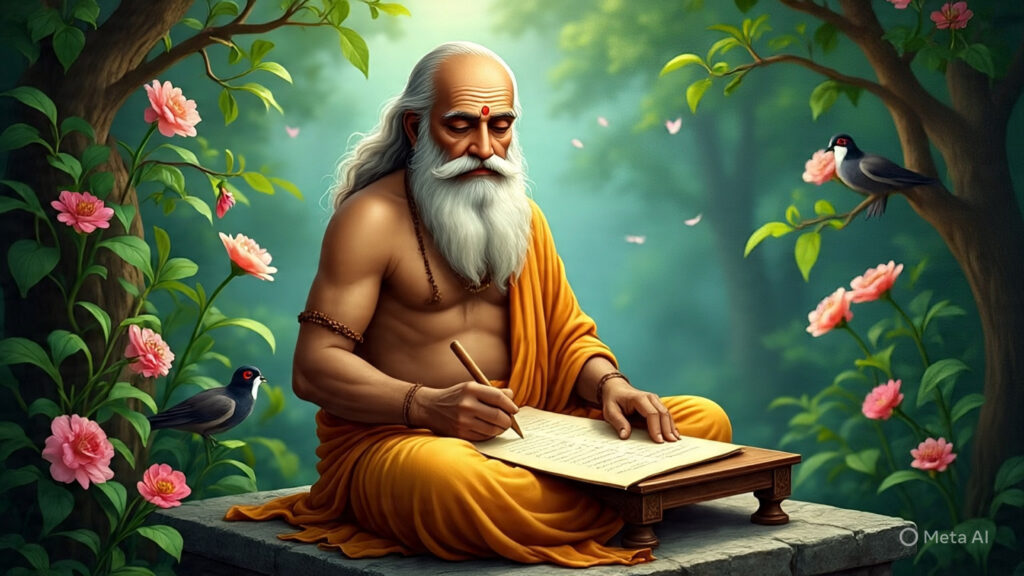What are the Vedānta – end of the Vedas?
Upaniṣad means “sitting at the feet of”. Also, Upaniṣads are considered to be texts which philosophically follow the Vedas, hence are also called Vedānta (end of the Vedas).
Additionally, while the Vedas cover many topics, Vedānta are almost exclusively devoted to the philosophical underpinning of Sanātana-dharma.
What are the features of the Upaniṣads?
- Firstly,Upaniṣads are part of a collection of material called vedānta (Veda + anta = end), meaning end of the Vedas.
- Next, all Upaniṣads deal more or less with the same subject. In fact, they explain the nature of the Brahman, the ātman (soul), mokshā (salvation) and the method of reaching it.
- Importantly, they are all generally believed to have been composed between 1000 BC and 1000 AD. Since, written scriptures were not common at the time, the Upaniṣads rely heavily on shruti (speech/ verse).
- Also, the most important Upaniṣads or mukhya-upaniṣads can be traced to the same period (1000 BC to 500 BC). Consequently, it is possible to assume that most of the authors were contemporaries and found different methods to reach the same goal.
- Furthermore, Buddhism was founded around the same period (Gautama Buddha – between 580 BC and 400 BC) as was Jainism as founded by Mahavira (between 480 BC and 408 BC). Hence, there is likely overlap of concepts and practices between the three major philosophical schools.
What are the different types of upaniṣad:
 Importantly though more than 108 Upaniṣads are known to exist, 12 are considered important of principal upaniṣads (mukhya-upaniṣad). These are:
Importantly though more than 108 Upaniṣads are known to exist, 12 are considered important of principal upaniṣads (mukhya-upaniṣad). These are:
- Īśā upaniṣad, part of śukla (white) Yajurveda – approximately 17-18 verses.
- Kena upaniṣad, part of Talavakara Brāhmana of Sāmaveda – 28 main + 6 epilogue = 34 verses
- Kaṭha upaniṣad, part of kṛṣṇa (black) Yajurveda – divided into two chapters, each with three subdivisions.
- Praṣna upaniṣad, part of Atharvaveda. It answers 6 questions and is set in three chapters and six sections.
- Muṇḍaka upaniṣad, part of Atharvaveda contains 64 verses divided into 3 parts (mundakams), each having two sections.
- Māṇḍūkya upaniṣad, part of Atharvaveda contains 12 short verses and discusses the nature of “Om” and 4 states of consciousness.
- Taittirīya upaniṣad, part of kṛṣṇa (black) Yajurveda is structured into 3 chapters, śikṣā-vallī having 12 lessons, ānanda-vallī having 9 lessons and brighu-vallī having 10 lessons, totalling to 31 lessons.
- Aitareya upaniṣad, part of Rigveda comprises the fourth, fifth and sixth chapters of the second book of aitareya-aranyaka which is one of the four layers of Rig Veda.
- Chāndogya upaniṣad is a part of Samaveda contains eight prapāṭhaka or lectures with many volumes and verses. Additionally, it is one of the oldest upaniṣads.
- Bṛhadāraṇyaka upaniṣad is a part of Shukla (white) Yajurveda. It contains 6 chapters.
- Śvetāśvatara-upaniṣad is a part of kṛṣṇa (dark) Yajurveda, arranged in 6 chapters containing 113 verses.
- Kauṣītaki upaniṣad is a common upaniṣad, originally part of Rigveda. Additionally, it is arranged in 4 chapters containing 5,15, 9 and 20 verses respectively.
- Maitrī upaniṣad is a part of kṛṣṇa-Yajurveda arranged in seven lessons
The following two ideas dominate the teaching of all the upaniṣads:
- First, final emancipation can be attained only by knowledge of the Ultimate reality, or Brahman (Brahmajnana).
- Second, those equipped with the four means of salvation, viz. vivekam (discrimination), vairāgyam (dispassion), shad-sampatham (the six-fold treasure; self-control, etc.) and mumukṣutva (yearning for liberation), can attain Brahman.
What you should know after reading this blog on vedānta.
- First, what is Vedānta? Additionally, what are the Upaniṣads?
- Secondly, how are they related to the Vedas?
- Importantly, what is the central theme of the Upaniṣads?
- How many Upaniṣads exist? Also, which are important?
- Lastly, how are the various Upaniṣads attached to Vedas?
- Finally, what is the central theme of the Upaniṣads?


